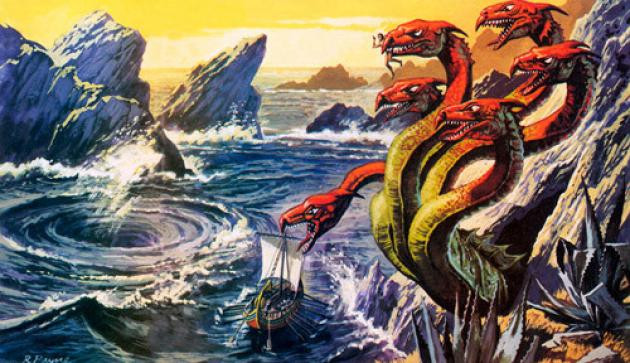Choosing between Scylla and Charybdis

38° 11′ 56.8572” N 15° 33′ 31.5648” E
23rd April
It’s not without a tension, we sail Ronja right between Scylla and Charybdis – the two legendary sea monsters who have guarded the entrance to the Messina Strait for thousands of years and called horror among seafarers. In addition to the two mythological monsters we have heard, that the Messina Strait today is a mess of crossing ferries, and that we should study the local tidal tables, as the strength of the tide can be even very strong.
Scylla was, according to the myths, a mighty six-headed monster with sharp teeth and a long scaly tail. She kept herself alive eating the seamen, who passed her. Charybdis was another monster who lurked on the seabed under a big whirlpool into which sailors were sucked if they came too close. If you sought to avoid Scylla, you came invariably too close to Charybdis. According to Homer, Odysseus decided to sail close to Scylla in order to lose only a few seamen instead of getting near Charybdis at the risk of losing the ship as well as the entire crew. Throughout the 18th century, British navy vessels were systematically encouraged to show extra attention when entering the Messina Strait from the north because of ekstraordinarely violent whirls in the water.
The two names still appear as local names in our naval chart. Charybdis is close to the Sicilian coast, and Scylla is on the mainland coast, exactly where the Messina Strait is at its most narrow. Well, today we still have whirls to pass, where the two monsters are said to have ruled. But the power has obviously been tamed. One possible scientific explanation may be, that a fierce earthquake changed the seabed in 1783, thus removing the foundations of the worst of the frantic whirls, which for a great many years kept the myth of Scylla and Charybdis alive.
Nor does the ferry-traffic scare us, it corresponds very much to the crossing between Elsinore and Helsingborg between Denmark and Sweden. And the potentially strong current is no worse, than to sail through Svendborg Sund in Denmark.
More unpredictable, however, are the winds that are formed by the tall mountains on both sides of the strait. Monsters or not: Increased attention is a good thing, when you sail into the Messina Strait from the north.
After a long day’s trip from Lipari we choose to go to the quay in Messina town, which do not, however convince us of its charm. It is a big and relatively new city. Most of its ancient buildings were smashed by an earthquake in 1908, which killed 100,000 inhabitants, and in 1943 the city was again completely injured under an ally bombardment.
The harbor is not protected from waves from the intense ferry traffic, so we got to get on.